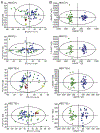Non-targeted metabolomics reveals diagnostic biomarker in the tongue coating of patients with chronic gastritis
- PMID: 31255854
- PMCID: PMC7383221
- DOI: 10.1016/j.jpba.2019.06.025
Non-targeted metabolomics reveals diagnostic biomarker in the tongue coating of patients with chronic gastritis
Abstract
Analysis of the properties of the tongue has been used in traditional Chinese medicine for disease diagnosis. Notably, tongue analysis, which is non-invasive and convenient compared with gastroscopy and pathological examination, can be used to assess chronic gastritis (CG). In order to find potential diagnostic biomarkers and study the metabolic mechanisms of the endogenous small molecules in the tongue coating related to CG, a non-targeted metabolomic analysis method was developed using ultra high performance liquid chromatography combined with quadrupole time-of-flight mass spectrometry (UHPLC-Q/TOF-MS). It was performed using two different columns in positive and negative ion scanning modes separately. The stability of the samples was evaluated and the age and gender factors of the subjects were excluded to ensure the reliability of the data in this study. Finally, under the four analysis models, 130, 229, 113 and 92 differential compounds were found using multivariate statistical methods respectively. 37 potential biomarkers were putatively identified after removing the duplicate compounds and five potential diagnostic biomarkers were putatively identified by receiver operating characteristic (ROC) curve analysis, including inosine, oleamide, adenosine, N-acetylglucosamine (GlcNAc) and xanthine. The main metabolic pathways associated with CG were purine metabolism, amino acid metabolism, sphingolipid metabolism and energy metabolism, which suggested that oxygen free radicals and energy metabolism were altered in patients with CG. These results provided a potential new basis for the quantitative diagnosis and pathogenesis of CG.
Keywords: Chronic gastritis; Diagnostic biomarker; Metabolomics; Tongue coating; UHPLC-Q/TOF-MS.
Copyright © 2019 Elsevier B.V. All rights reserved.
Figures






Similar articles
-
The metabolites mainly composed of lipids in tongue coating are non-invasive potential biomarkers for chronic gastritis.Sci Rep. 2024 Jul 30;14(1):17574. doi: 10.1038/s41598-024-68261-6. Sci Rep. 2024. PMID: 39079952 Free PMC article.
-
Metabolic markers and microecological characteristics of tongue coating in patients with chronic gastritis.BMC Complement Altern Med. 2013 Sep 17;13:227. doi: 10.1186/1472-6882-13-227. BMC Complement Altern Med. 2013. PMID: 24041039 Free PMC article.
-
Dynamic urinary metabolomics analysis based on UHPLC-Q-TOF/MS to investigate the potential biomarkers of blood stasis syndrome and the effects of Danggui Sini decoction.J Pharm Biomed Anal. 2020 Feb 5;179:112986. doi: 10.1016/j.jpba.2019.112986. Epub 2019 Nov 15. J Pharm Biomed Anal. 2020. PMID: 31787459
-
Metabolomics of papillary thyroid carcinoma tissues: potential biomarkers for diagnosis and promising targets for therapy.Tumour Biol. 2016 Aug;37(8):11163-75. doi: 10.1007/s13277-016-4996-z. Epub 2016 Mar 2. Tumour Biol. 2016. PMID: 26935059
-
Translational Metabolomics of Head Injury: Exploring Dysfunctional Cerebral Metabolism with Ex Vivo NMR Spectroscopy-Based Metabolite Quantification.In: Kobeissy FH, editor. Brain Neurotrauma: Molecular, Neuropsychological, and Rehabilitation Aspects. Boca Raton (FL): CRC Press/Taylor & Francis; 2015. Chapter 25. In: Kobeissy FH, editor. Brain Neurotrauma: Molecular, Neuropsychological, and Rehabilitation Aspects. Boca Raton (FL): CRC Press/Taylor & Francis; 2015. Chapter 25. PMID: 26269925 Free Books & Documents. Review.
Cited by
-
Identification of the Biomarkers for Chronic Gastritis with TCM Damp Phlegm Pattern by Using Tongue Coating Metabolomics.J Inflamm Res. 2024 Nov 2;17:8027-8045. doi: 10.2147/JIR.S480307. eCollection 2024. J Inflamm Res. 2024. PMID: 39507266 Free PMC article.
-
High-throughput metabolomics exploring the pharmacological effects and mechanism of icariin on rheumatoid arthritis rat based on ultrahigh-performance liquid chromatography coupled with quadrupole time-of-flight mass spectrometry.Front Mol Biosci. 2025 Apr 9;12:1514882. doi: 10.3389/fmolb.2025.1514882. eCollection 2025. Front Mol Biosci. 2025. PMID: 40270592 Free PMC article.
-
Microbiome and metabolome integrated analysis: exploring potential diagnostic approaches for Parkinson's disease using tongue coating samples.Front Microbiol. 2025 Jul 29;16:1621468. doi: 10.3389/fmicb.2025.1621468. eCollection 2025. Front Microbiol. 2025. PMID: 40800112 Free PMC article.
-
Untargeted Metabolomics Analysis Using UHPLC-Q-TOF/MS Reveals Metabolic Changes Associated with Hypertension in Children.Nutrients. 2023 Feb 6;15(4):836. doi: 10.3390/nu15040836. Nutrients. 2023. PMID: 36839194 Free PMC article.
-
Serum Metabolomic Analysis of Synchronous Estrus in Yaks Based on UPLC-Q-TOF MS Technology.Animals (Basel). 2024 May 7;14(10):1399. doi: 10.3390/ani14101399. Animals (Basel). 2024. PMID: 38791618 Free PMC article.
References
-
- Rahmani A, Moradkhani A, Hafezi Ahmadi MR, Jafari HA, Abangah G, Asadollahi K, Association between serum levels of high sensitive C-reactive protein and inflammation activity in chronic gastritis patients, Scand. J. Gastroenterol 51 (2016) 531–537. - PubMed
-
- Zagari RM, Rabitti S, Greenwood DC Eusebi LH, Vestito A, Bazzoli F, Systematic review with meta-analysis: diagnostic performance of the combination of pepsinogen, gastrin-17 and anti-Helicobacter pylori antibodies serum assays for the diagnosis of atrophic gastritis, Aliment. Pharmacol. Ther 46 (2017) 657. - PubMed
MeSH terms
Substances
Grants and funding
LinkOut - more resources
Full Text Sources

